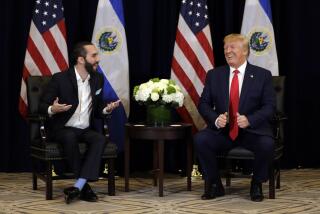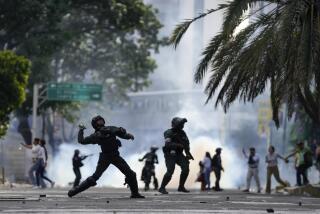The Melding Americas : Diplomacy : End of Cold War Has Radically Changed U.S.-Latin Relations : Most happy to see end to heavy-handedness, but fear neglect by Washington.
The new American ambassador to Nicaragua stunned observers earlier this year when he acknowledged that the history of U.S. actions in Central America had essentially encouraged dictators and weakened national political systems.
As he met with polarized Nicaraguaâs left and right, U.S. Ambassador John Maisto also carried this new message: Solve your own problems, Nicaraguans, because the United States is staying out of the fray.
Wait a minute.
Was this not a representative of the same country whose government spent years and millions bolstering one heavy-handed leader--Anastasio Somoza--and then spent more years and more millions to topple another--Daniel Ortega and his Sandinista colleagues?
The same country that gave us William Walker, the 19th-Century adventurer who declared himself president of Nicaragua? The same country that, for as long as any Nicaraguan could remember, had been meddling in Nicaraguan affairs--often at the invitation of rival Nicaraguan groups?
Nicaraguans were confused. Those who had routinely turned to Washington for help felt abandoned. Those who had been Washingtonâs enemies, like the Sandinistas, harbored skepticism. But some Nicaraguans liked what they heard and went about the business of trying to rebuild a country wrecked by war and poverty.
Maistoâs arrival in the Managua milieu illustrates the changing relationship between Washington and Central America and the other nations of the hemisphere, a relationship no longer painted in the simplistic colors of the Cold War, no longer based solely on security issues.
âThe Clinton Administration has the opportunity to begin a new generation, a new policy and a new era in the polarizing and contradictory relations that Washington has maintained with Managua for more than a century . . . and (with) the rest of Central America,â said Xabier Gorostiaga, a Jesuit priest who heads the University of Central America in Managua.
âWe cannot fail to take advantage of this new attitude,â he added, advocating a restructuring of U.S. economic aid to target small farmers instead of large producers.
Mexico expects to parlay the North American Free Trade Agreement into a lasting partnership with U.S. business. Chile hopes to gain entry into a regional trade agreement similar to Mexicoâs. And Argentinaâs quest for closeness with the U.S government has been a cornerstone of its foreign policy ever since the 1989 election of President Carlos Saul Menem. The relative stability of most of South America in recent years makes it an appealing partner for North American officials and entrepreneurs.
But nowhere has the shift in geopolitical dynamics been more dramatic than in Central America, where the thrust of U.S. policy for the entire decade of the 1980s boiled down to one goal: fighting communism.
This meant pouring money and offering unlimited military training to wage war against Marxist guerrillas, such as the Farabundo Marti National Liberation Front, or FMLN, of El Salvador, and leftist governments such as the Sandinista regime. It meant forming alliances with governments and movements for the shared, singular objective of stopping a Soviet-backed menace. It often meant ignoring or downplaying the human rights records and corrupt practices of some of those allies, such as the Honduran army and the Salvadoran right.
The governments of Central America that were U.S. allies became adept at enunciating the same goals, and they benefited as the aid flowed in.
Today, Washingtonâs relationship with Central America is more complex. In some cases, onetime friends on the right are now Washingtonâs bitter adversaries, while former foes on the left attend U.S.-financed business seminars. And in a startling reversal from previous decades, Washington has found itself sitting on the sidelines of some Central American political disputes and elections, while Central American governments have declined to toe the U.S. line on Haiti, at the population conference in Cairo and in other matters.
Some critics of past policy say the relationship today is more healthy, more diverse. Others say it suffers from inattention and neglect. Many Central Americans believe that, after a decade of being a focal point of U.S. policy, the region has fallen off the map. The once plentiful money is drying up, and some capitals went months without U.S. ambassadors, something that would have been unthinkable in the decade of intervention.
âCompared to the past, relations have obviously improved, in that the United States no longer gets involved directly in the internal affairs of Central American countries. There is no reason to do so,â said Joaquin Tacsan, an official of Costa Ricaâs Arias Foundation, a think tank run by former President Oscar Arias, the 1987 Nobel laureate for his regional peace-building efforts.
âBut on the other hand, the improvements have provoked the other extreme: indifference. Central American countries feel they have been displaced from the eyes of the world.â
The Central American countries that emerged from the 1980s are, generally speaking, more democratic than they were 10 years ago. Opposition parties are able to participate in politics without a high physical risk. The wars have ended in El Salvador and Nicaragua, and may soon end in Guatemala.
But with some exceptions, the countries are also poorer than ever and are faced with huge, costly tasks of reconciliation and reconstruction. The elite continue to enjoy impunity, and justice systems remain flawed.
With U.S. economic aid slashed to a fraction of its previous levels, many Central Americans are now looking to the United States for investors and partners in trade. Governments are pursuing free-market policies, which promote economic growth and appeal to U.S. business, but can plunge the poor deeper into poverty.
Also receiving U.S. attention, albeit on a secondary level, is the building of democratic institutions. A new civilian police force in El Salvador is largely financed and trained by Americans.
And some governments, notably those of El Salvador and Guatemala, have pleaded for a more lenient U.S. immigration policy. More than a million Salvadorans fled north during the last decade, and the money they send home keeps the Salvadoran economy afloat. Large-scale deportations would spell disaster.
In the more than two years since a U.N.-sponsored peace process ended the Salvadoran civil war, the Salvadoran government has had to adjust to a new Washington agenda with different kinds of strings attached. There is less money to go around, and the former rebels, who laid down their weapons and formed a political party, are receiving a share of it--much to the chagrin of the United Statesâ former allies on the right.
Through a U.S.-funded land bank, for example, former rebels have been given seed money to start coffee cooperatives and other agricultural projects.
Some on the right and in the military, who became accustomed to preferential treatment as long as they presented a unified front against communism, feel left out and have become born-again patriots.
âStrangely, the American Administration today forgets that the FMLN was its true enemy,â said Kirio Waldo Salgado, one of El Salvadorâs most vocal commentators on the far right.
Another sign of changing dynamics came with El Salvadorâs presidential election in April. For the first time in recent memory, the U.S. government did not back anyone in the contest, which pitted a candidate from the ruling right against one who had the support of the former guerrillas.
The leftâs candidate, former legislator Ruben Zamora, lost. But during the campaign he frequently marveled at the lunch invitations that he, once an outcast, was receiving from the U.S. Embassy.
âThe crux of the discussion between the United States and Latin America is no longer communism and anti-communism, leftist and rightist,â Zamora said. âThese things are increasingly irrelevant. The crux today is something else--itâs free trade (and) the capacity of political groups to guarantee stability inside the countriesâ of Latin America.
Nevertheless, leftists in El Salvador and Guatemala continue to protest when U.S. troops arrive to build roads and bridges. Many see an ulterior motive to the rapprochement, believing U.S. officials are currying favor with moderate leftists, hoping to isolate the more extreme elements.
And in Nicaragua--despite Ambassador Maistoâs upbeat approach--the years of mistrust have not been completely erased.
The U.S. Senate, largely at the behest of Jesse Helms, continues to periodically threaten to cut off aid to Nicaragua because of disputes over property confiscated during Sandinista rule. And officials in President Violeta Barrios de Chamorroâs government are resentful of what they see as the failure of the United States to come through with promised postwar aid.
As they prepare for the Summit of the Americas with President Clinton in Miami in December, Central American leaders are going over their wish lists.
Most agree that the summit should concentrate on economic issues: strengthening commercial ties, expanding markets for Central American textiles and foods, limiting quotas on key exports such as bananas and sugar and devising a plan of sustainable development.
But among the Central American countries, in contrast to neighbors in South America, there is little agreement. Each government seems bent on defending the interests of its own tiny economy, analysts say. That discord threatens to undermine any effort by Central America to emerge as a trading bloc.
More to Read
Sign up for Essential California
The most important California stories and recommendations in your inbox every morning.
You may occasionally receive promotional content from the Los Angeles Times.










